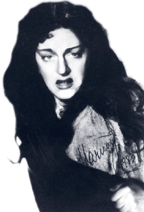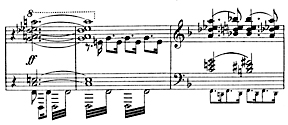Dramatic structure in Strauss’s Elektra by Michel Veilleux
/ May 1, 2001
Version française...
 W hen Richard Strauss saw Hugo von Hofmannsthal’s play Elektra in 1904, he was immediately captivated by this free adaptation of the Sophocles classic and wanted to use it for an opera. Nevertheless, he hesitated. Strauss thought Elektra had too much in common with Oscar Wilde’s Salome, which he was then setting to music. In the end, Hofmannsthal convinced Strauss that the two plays were fundamentally different, and by 1906 Strauss set to work on the libretto and then began composing the opera. It was finished in 1908 and premiered in Dresden in January, 1909. W hen Richard Strauss saw Hugo von Hofmannsthal’s play Elektra in 1904, he was immediately captivated by this free adaptation of the Sophocles classic and wanted to use it for an opera. Nevertheless, he hesitated. Strauss thought Elektra had too much in common with Oscar Wilde’s Salome, which he was then setting to music. In the end, Hofmannsthal convinced Strauss that the two plays were fundamentally different, and by 1906 Strauss set to work on the libretto and then began composing the opera. It was finished in 1908 and premiered in Dresden in January, 1909.
Strauss decided to make large cuts in the Hofmannsthal
text (nearly 40%) and switched various passages, sometimes transferring a few
lines from one scene to another. He also asked Hofmannsthal to add “some fine
poetry” in two particular places. Behind each of these changes there was a
profound logic indicative of Strauss’s extremely sharp sense of telling a story
for the stage. Even so, Strauss kept the order of the eight
distinct scenes
that figured in the original. These were:
|

The Author's
favourite Elektra
Astrid
Varnay
(1949) |
Introduction
- The servants’ prologue
- Elektra alone
Development
-
Elektra and Chrysothemis (1st scene)
-
Elektra and Clytemnestra
-
Elektra and Chrysothemis (2nd scene)
-
Elektra and Orestes
Conclusion
- Elektra and Aegisthus
-
Elektra and Chrysothemis |
The first two scenes are clearly the introduction to the story. The servants’ prologue shows them drawing water from a well and repeating Elektra’s acerbic comments about them. They give us a portrait of the heroine, and describe how Elektra has lived in the courtyard of the royal palace since the murder of Agamemnon. She dresses in rags and sits with the dogs, disdaining everyone who is unfaithful to her father’s memory. Strauss’s angry music immediately creates the atmosphere of violence and cruelty typical of the work and evocative of Elektra’s implacable resolve.
The second scene is a major monologue in two parts. The first describes the underlying problem—a traditional feature of all mythology. Upon his return from the Trojan war, King Agamemnon was brutally murdered in his bath by his wife, Queen Clytemnestra, with the aid of her lover, Aegisthus. Since that day Elektra has lived for one thing only.: the moment of vengeance—the day her brother Orestes returns to avenge his father by killing his mother. Every evening Elektra relives the moment of her father’s murder.
In the second part of her monologue, Elektra foresees the day of vengeance. The villains will be punished, Agamemnon’s animals will be sacrificed, and his children will dance triumphantly on his grave. The wild dance music heard at this point foreshadows the end of the opera, when the same music is repeated.
Confrontations
With the third scene, featuring Elektra and her sister Chrysothemis, the plot begins to develop using a series of confrontations. As Jacqueline de Romilly has pointed out in La tragédie grecque (Paris 1992), “the tragedies of Sophocles are constructed as a series of confrontations in which the hero faces other characters, for the purpose of conveying feelings and ideals more sharply.” The confrontations correspond to central episodes, each embodying a turning point. Scene three is the first such episode. Chrysothemis is everything that Elektra is not. She’s much more conventional, upholds bourgeois values, and only wants to marry and have children. She is not interested in making a point of delity to her father’s memory and no longer hopes for the return of Orestes. To emphasize the antagonism between the two sisters, Strauss has given Chrysothemis music that is intensely lyrical and emotionally fraught—the complete opposite of Elektra’s violent and broken style in the introduction. The lyrico-dramatic soprano voice of Chrysothemis must also be in marked contrast with Elektra’s dark, rich dramatic soprano.
Modernist nightmares
The second episode gives us Elektra confronting her mother, Clytemnestra (4), whom she holds responsible for her father’s death. Hofmannsthal and Strauss have given us a moving portrait of the sleepless queen, filled with anguish and remorse—a role vocally represented by a contralto. In an astonishing passage, Clytemnestra confides in her daughter, describing the nightmares that haunt her. The music, becoming completely atonal for the moment, reveals the queen’s psyche. This is certainly the most modern music in the entire opera, produced in the very year (1908) Schoenberg left tonal music behind.
The confrontation between the two women reaches its climax during a long and savage monologue in which Elektra describes in detail how the queen will perish at the hand of her son Orestes in order to expiate her crime. The purpose of these two long episodes (scenes 3 and 4) is to develop what had already been stated in the introduction.
The
moment approaches
Suddenly, one of the queen’s maids murmurs something in her ear, and Clytemnestra’s expression changes abruptly from stupefaction to joy. Shortly afterward, Chrysothemis enters to announce the arrival of two strangers who have come to the palace with the news that Orestes has met with a fatal accident. This communication marks the turning point.: Elektra’s attitude undergoes a radical change. From being a passive protagonist waiting for a just punishment, she becomes a heroine determined to act. During her second confrontation with Chrysothemis (5), Elektra tries to persuade her sister to join in her plan to kill Clytemnestra and Aegisthus in their sleep. Since her brother is dead, Elektra now considers it her duty to avenge her father. The intense lyrical quality of the first confrontation with Chrysothemis (3) returns, but this time as an accompaniment to Elektra’s seductive entreaties. But this time Chrysothemis refuses to go along with Elektra’s plans and finally flees in terror. Elektra must act alone.
In the following scene (5), Elektra is surprised by a stranger while digging up the hatchet that will be used to kill her mother. She pretends to be a palace servant and questions the stranger, who tells her he is a friend of Orestes and recounts his accidental death. Seeing Elektra’s violent reaction and sorrow on hearing the news, the stranger asks her if she is related to Orestes and Agamemnon. Elektra admits being of the same blood, and Orestes tells her his true identity.
The reunion between brother and sister is one of the most famous and moving scenes in all Greek tragedy. The confrontation between Orestes and Elektra is really the symmetrical opposite of the stand-off between Elektra and Clytemnestra (4) that ended the first half of the story. The question and answer formula is the same, as is the system of conveying information through successive accounts by various characters. We see the same pity and introspection. Elektra’s intense emotion upon recognizing her brother translates into a resounding, dissonant chord played fortissimo by the orchestra. The chord gradually subsides into a profoundly calm mode in which Elektra conveys her immense joy at finding herself at last face to face with her beloved brother. She then plunges into a more introspective passage, where she painfully describes the story of her suffering. This moment of high moral self-examination is typical of the end of the plot development in classical literature.
Final
vengeance
After this scene, the plot can move to its conclusion. Orestes tells his sister that he has made up his mind to avenge his father. Elektra encourages him, and the orchestra embarks on a theme expressing achievement. The opera’s end is near, as shown by Orestes entering the palace with his tutor and guided by his servants. Now comes the moment that both the heroine and the audience have been waiting for since the end of the introduction.: the vengeance killing of Clytemnestra. This takes place in the wings, as is the tradition in classical theatre. At the moment of Clytemnestra’s dying scream, Elektra, now alone on the stage, exults.
 |
|
The moment of
recognition. |
In the last confrontation (7), it is Elektra and her step-father Aegisthus who are juxtaposed. Strauss’s music paints a highly caricatured picture of Aegisthus. He is grotesque, an object of derision. Elektra invites him to enter the palace and meet the two strangers who came with the news that Orestes was dead. Aegisthus is then killed, the action occurring in the wings, as always.
We have reached the final stage of the narration, the last scene in which Electra and Chrysothemis are placed in opposition (8). It marks the moment of rejoicing now that the avenging murders have taken place. Chrysothemis reveals her great joy and exhorts her sister to join in the festivities inside the palace. But Elektra is already in another world. She has lived only for the moment of vengeance, and now she has no further reason to live. She does a wild and triumphant dance, and then falls to the ground, dead.
[Translated by Jane Brierley]
The MSO will perform a concert version of Elektra on May 29 and 30.
Info: (514) 842-9951.
Version française... |
|


